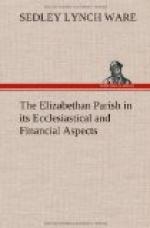Bequests made to the highways or bridges were considered as donated in pios usus. “I thinke,” wrote a prebendary of Durham Cathedral in 1599, “it also a deade of charitie and a comendable worke before God to repaire the high-wayes, that the people may travaille saifely without daunger. I therefore will to the mending of the highwayes [etc.]...."[235]
Noblemen and wealthy men were expected to help maintain the local poor in particular. Elizabethan ballads celebrate the liberality to the destitute of an Earl of Huntingdon,[236] of an Earl of Southampton,[237] or of an Earl of Bedford.[238] At the funeral of George, Earl of Shrewsbury, in 1591, eight thousand got the dole served to them, and it was thought that at least twice that number were in waiting, but could not approach because of the tumult.[239] The churchwardens and overseers of the poor accounts, especially in London and the larger cities, abound with receipt items of gifts from great personages or wealthy merchants.[240]
Owing to the difficulty of investing money because present-day intermediaries were absent between capital seeking employment and would-be borrowers; and because the medieval stigma attaching to money loaned at interest had by no means wholly disappeared,[241] there grew up in Elizabethan parishes a system of laying out money, raised by the parish or donated by benefactors, in various trades, such as wool-spinning, linen-weaving, the buying of wood or coal to sell again at a profit,[242] etc. Sometimes well-to-do parishioners with good credit would themselves borrow parish money, returning ten per cent. for its use.[243] Usually, however, parish money was loaned gratis, the parish taking sureties for its repayment and sometimes articles of value, being, apparently, not always above doing a little pawnbroking business.[244] On the other hand, when the parish itself had occasion to borrow money it would occasionally give its own valuables as security. Thus the Mere, Wiltshire, wardens record in 1556 that they have redeemed on the repayment of 40s. to one Cowherd, “borowed of hym to thuse of the Churche,” “certeyn sylver Spones of the Churche stocke."[245] Finally, parishes would now and then make some cautious speculation in real estate, such as the buying of a local market or fair with a view to profit.[246]
Leaving the subject of endowments we shall now take up in order the measures which may be called Parish Expedients for raising money.
Of all means ever devised for obtaining large sums of money for parish uses, the most popular, as certainly the most efficacious, was the Church-ale. Widespread during the first years of Elizabeth’s reign, church-ales, for reasons hereafter to be mentioned, ceased to be held in many parishes towards the end of the reign. They constitute, nevertheless, at all times during the 16th century an important chapter in the history of parochial finance. In some wardens’ accounts the proceeds of these




